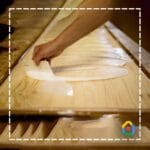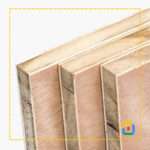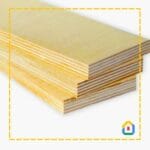In the realm of construction and interior design, safety and durability are paramount concerns. Among the various materials used in these fields, Fire Retardant Plywood in India has emerged as a crucial solution to mitigate fire hazards and enhance structural integrity. In this comprehensive guide, we will delve into the world of Fire Retardant Plywood in India, uncovering its characteristics, applications, grades, advantages, and much more.
Understanding Fire Retardant Plywood
What is Fire Retardant Plywood?
Fire Retardant Plywood, often referred to as “FR Plywood,” is a specialized type of plywood engineered to resist the spread of fire. It is designed to slow down the combustion process, providing valuable time for evacuation and firefighting efforts in the event of a fire. Fire Retardant Plywood is a significant advancement in building safety, particularly in areas where fire protection is critical.
Composition
Fire Retardant Plywood is constructed similarly to standard plywood, with a few key differences in its composition to achieve its fire-resistant properties. The primary components of Fire Retardant Plywood include:
- Veneer Sheets: Thin wood veneer sheets make up the layers of Fire Retardant Plywood. These veneers are usually sourced from common wood species like birch or pine.
- Fire Retardant Treatment: The critical element that distinguishes Fire Retardant Plywood is the treatment applied to the veneer sheets. This treatment involves impregnating the veneers with fire-resistant chemicals that inhibit the spread of flames.
- Adhesive: The veneer sheets are bonded together using adhesive, similar to standard plywood, to create a composite material.
Manufacturing Process
The production of Fire Retardant Plywood involves a meticulous manufacturing process to ensure its fire-resistant properties:
- Veneer Treatment: The veneer sheets undergo a specialized treatment process where they are impregnated with fire-resistant chemicals. These chemicals penetrate the wood fibers, making them less susceptible to combustion.
- Layer Assembly: The treated veneer sheets are stacked and arranged to create the desired thickness of the plywood panel.
- Gluing: The veneer stack is bonded together using adhesive, typically phenol-formaldehyde or urea-formaldehyde resin, just like standard plywood.
- Pressing: The veneer stack is placed in a hydraulic press, where it undergoes pressure and heat to activate the adhesive and create a solid plywood panel.
- Cutting and Finishing: Once the Fire Retardant Plywood sheets are formed, they are cut to size, sanded for a smooth finish, and trimmed to remove any defects.
Grades of Fire Retardant Plywood
Fire Retardant Plywood is available in different grades, each indicating its fire resistance and suitability for specific applications. In India, Fire Retardant Plywood grades are categorized based on their resistance to fire, and they include:
1. Fire Retardant (FR) Grade
FR Grade Fire Retardant Plywood offers basic fire resistance, providing protection against the spread of flames. It is commonly used in areas where fire safety is a concern but not necessarily a critical requirement. FR Grade plywood is suitable for interior applications such as partition walls, ceilings, and furniture.
2. Fire Retardant Exterior (FRE) Grade
FRE Grade Fire Retardant Plywood offers a higher level of fire resistance and can be used in exterior applications. It is often employed in building facades, exterior walls, and other outdoor structures to enhance fire safety.
3. Fire Retardant Marine (FRM) Grade
FRM Grade Fire Retardant Plywood is designed to withstand both fire and water exposure. It is suitable for marine applications where fire protection is vital, such as boat interiors and ship cabins.
4. Fire Retardant Decorative (FRD) Grade
FRD Grade Fire Retardant Plywood combines fire resistance with aesthetic appeal. It is used for interior applications where both safety and design are important, such as decorative wall paneling and furniture.
Advantages of Fire Retardant Plywood
Fire Retardant Plywood offers numerous advantages that make it a valuable addition to various building and design projects:
1. Fire Safety
The primary advantage of Fire Retardant Plywood is its ability to slow down the spread of fire. It can provide crucial additional time for evacuation and firefighting efforts, reducing the risk to human lives and property.
2. Compliance with Building Codes
Fire Retardant Plywood is designed to meet stringent fire safety standards and building codes. Its use ensures compliance with regulations related to fire protection.
3. Versatility
Fire Retardant Plywood is versatile and can be used in a wide range of interior and exterior applications. It can provide fire protection in various settings, from residential buildings to commercial structures.
4. Enhanced Structural Integrity
In addition to fire resistance, Fire Retardant Plywood maintains its structural integrity even when exposed to fire. This ensures that it continues to perform its intended functions during a fire event.
5. Aesthetic Options
Fire Retardant Plywood is available in decorative grades, allowing designers to incorporate fire safety without sacrificing aesthetics. It can be used to create visually appealing interiors and furnishings.
6. Durability
Fire Retardant Plywood retains its durability and resistance to decay and insects, making it a long-lasting material for construction and design projects.
7. Peace of Mind
Using Fire Retardant Plywood provides peace of mind, knowing that the structure or interior elements are equipped with an added layer of protection against fire hazards.
Applications of Fire Retardant Plywood
Fire Retardant Plywood finds applications in a variety of settings where fire safety is a concern. Some of its primary uses include:
1. Interior Wall Panels
Fire Retardant Plywood is commonly used for interior wall paneling in buildings, particularly in areas with a higher risk of fire, such as stairwells, corridors, and commercial kitchens.
2. Ceilings
In commercial buildings, Fire Retardant Plywood is used for ceilings to enhance fire safety while providing an aesthetically pleasing finish.
3. Partitions
It is used to create fire-resistant partitions and dividers within buildings, helping to compartmentalize spaces and prevent the spread of fire.
4. Furniture
Fire Retardant Plywood is used in the manufacturing of furniture, especially in commercial and public spaces where fire safety regulations are stringent.
5. Doors
Fire-rated doors, which are essential for fire exits and high-risk areas, are often constructed using Fire Retardant Plywood.
6. Commercial Kitchens
In commercial kitchens, where the risk of fire is high due to cooking equipment, Fire Retardant Plywood is used for cabinetry and wall coverings.
7. Theatres and Auditoriums
In theatres and auditoriums, Fire Retardant Plywood is used for stage construction, seating, and interior finishes to enhance fire safety during performances.
8. Hospitals
Hospitals use Fire Retardant Plywood in areas such as patient rooms, corridors, and laboratories to ensure the safety of occupants and sensitive equipment.
9. Hotels
Fire Ret
ardant Plywood is incorporated into hotel interiors, particularly in guest rooms, to provide both safety and aesthetic appeal.
Maintenance and Care
Proper maintenance and care are essential to ensure the continued fire resistance and performance of Fire Retardant Plywood:
- Inspect Regularly: Periodically inspect Fire Retardant Plywood surfaces for any damage, wear, or signs of deterioration.
- Clean with Care: Use gentle cleaning methods to avoid damaging the fire-resistant treatment. Avoid abrasive cleaners that may remove the fire-retardant chemicals.
- Repair or Replace: Address any damage promptly. Damaged sections may need to be repaired or replaced with fire-retardant-treated plywood to maintain fire protection.
- Compliance: Ensure that any modifications or repairs made to Fire Retardant Plywood components comply with fire safety regulations and building codes.
- Re-Treatment: Over time, the fire-retardant properties of plywood may diminish. In such cases, consider re-treating the plywood to restore its fire resistance.
Conclusion
Fire Retardant Plywood stands as a testament to human innovation in ensuring the safety and security of built environments. In India, where fire safety is a critical concern, this remarkable material has found its place in a wide array of applications, from residential interiors to commercial structures. Its ability to slow down the spread of fire, coupled with its versatility and aesthetic options, makes it an indispensable asset in the toolkit of architects, builders, and designers. As India continues to grow and evolve, Fire Retardant Plywood will play a pivotal role in safeguarding lives and property against the ever-present threat of fire.

























